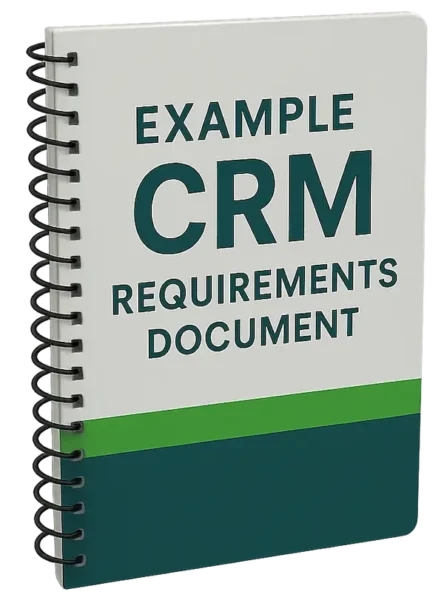If the following has ever happened to you, raise your hand: You’re in a meeting at a new company or client. A lot of three-letter acronyms (TLAs) are being thrown around.
You don’t know what some of them mean. You don’t want to appear foolish, so you pretend to understand each abbreviation while discreetly jotting down as many of them as possible on your notepad. When the meeting is over, you rush to your computer or grab your smartphone and search for definitions of the terms you just heard.

You’re not alone—we’ve all experienced acronym confusion at some point. The worlds of CRM and digital marketing are brimming with jargon and acronyms.
To help you catch up, we’ve created a quick guide to prepare you for a better experience in a TLA-rich environment.
Popular Acronyms
Here are some common acronyms you’ll see and hear that relate to marketing, leads, prospects, management, reporting, and more.
CRM – Customer Relationship Management
Let’s start with CRM (Customer Relationship Management). The press sometimes misstates this as “Customer Relations Management.”
‘CRM’ is a multi-purpose acronym.
There are many CRM software vendors, including Salesforce, HubSpot, and Zoho.
The classic CRM functionality areas are sales, marketing, and customer service, but a CRM database and its front-end UX can be extended to automate various business processes.
Software aside, the abbreviation ‘CRM’ defines a strategy businesses use to improve customer relationships. The desired result of this strategy is often to increase revenue and lower costs.
CRM is also the ticker symbol for Salesforce, Inc.
The following is a group of CRM-related acronyms we have assembled.
PRM – Multiple ‘P’ Options
PRM is a spinoff of the CRM acronym. PRM is used for Partner Relationship Management, Physician Relationship Management, and Patient Relationship Management.
ABM – Account-Based Marketing
Account-Based Marketing (ABM) is an alternative B2B strategy that focuses sales and marketing resources on a clearly defined set of target accounts within a market and uses personalized campaigns designed to resonate with each account.
Think scalpel instead of a shotgun — that’s ABM in a nutshell.
MQL – Marketing Qualified Lead
Marketing Qualified Leads are people who have shown signs of interest in buying. They’ve taken an initial step to engage with your business beyond a website visit or social media view. An MQL is primed to receive additional communication.
Marketing Qualified Leads (hopefully) turn into Sales Qualified Leads, which then turn into customers.
SAL – Sales Accepted Lead
Sales Accepted Leads are the bridge between Marketing Qualified and Sales Qualified Leads. A ‘SAL’ is a lead the sales team has agreed to pursue but has not yet spoken with to determine whether they are qualified prospects.
If a SAL is contacted and expresses interest in buying, they will likely be converted to a Sales Qualified Lead.
SQL – Sales Qualified Lead
A Sales Qualified Lead is a prospective customer that has been researched and vetted by an organization’s marketing and sales teams. The lead has been deemed ready for the next stage in the sales process. In many cases, an opportunity is created in the CRM system for an SQL.
Every organization has a slightly different process and criteria for moving an MQL to a SAL — and then to an SQL.
SDR – Sales Development Representative
Previously known as “inside sales reps,” Sales Development Representatives focus primarily on outbound prospecting. They may use tools such as ZoomInfo, Outreach, or SalesLoft. Sales development reps aren’t responsible for closing the business; they focus on moving leads through the pipeline.
BDR – Business Development Representative
Business Development Representatives (BDRs) can overlap with SDRs. In some companies, the two are synonymous. However, other companies differentiate BDRs and SDRs by the type of leads & relationships they handle.
BDRs are sometimes responsible for the bigger picture, including strategic relationships and partner development.
CRO – Chief Revenue Officer
The Chief Revenue Officer role is a relatively new TLA born in Silicon Valley. Common in tech companies, a CRO drives revenue growth by leveraging and aligning all revenue-generating departments, including marketing, sales, and customer experience/success.

CRO is also an acronym for Conversion Rate Optimization, which involves maximizing the number of website visitors who submit a web form, send an email, chat, or call.
RSM – Regional Sales Manager
A Regional Sales Manager sells a company’s products or services within a defined geographic region.
In many organizations, field salespeople report to an RSM.
KPI – Key Performance Indicators
Key Performance Indicators (KPIs) are measurable values that demonstrate how effectively a company achieves its key business objectives. Organizations use KPIs at multiple levels to evaluate their progress toward targets.
Examples of KPIs include:
- Return on Investment
- Cost of Goods Sold
- Customer Lifetime Value
- Employee Turnover Rate
- Sales by Region
Unsurprisingly, many KPIs are also three-letter acronyms. You need to know all the acronyms if you’re in charge of monitoring and/or organizing your company’s KPI reports.
SOP – Standard Operating Procedure
In recent years, SOPs have become popular for documenting processes and procedures.
Accelerating their adoption is that LLMs can be prompted to generate solid first drafts of standard operating procedures, which can then be human-edited.
In turn, a CRM platform can automate processes outlined in SOPs.
OKR – Objectives and Key Results
OKR is another acronym that has gained popularity in recent years.
Objectives are qualitative descriptions of something you want to achieve in business. A CRM-related object might be ‘reduce customer churn.’
Key Results are metrics that measure your progress toward a defined objective.
CTA – Call to Action
A call to action is any text, image, video, or other media designed to get an immediate response from the person reading or hearing it. CTAs are widely used in digital marketing strategies to generate leads and drive sales.
Incidentally, the plural of ‘call to action’ is ‘calls to action.’
We hope this CRM-related acronyms glossary helps you absorb more information in your next meeting or contribute more to an upcoming conversation.
If you’re researching CRM vendors or buying software for your organization, you’ll better understand the industry acronyms that often get thrown around.



